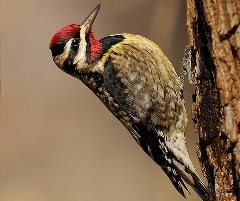If the 70 degree days last week didn't convince you that spring is coming, I'm here to remind you of what's ahead this month: Spring beauties! Spring Peepers! And all kinds of other cool stuff. What have you been seeing lately?
Bloodroot is one of our favorite spring flowers. Each plant blooms only briefly, and there's a window of only a few weeks that the bloodroots bloom at all. It's one more thing that inspires us to spend as much time as possible in the woods at this time of year.
Every year we look for the cheery flowers of the
spicebush as they emerge to light up the understory. It's common throughout our local forests.
Spring peepers are another pilgrimage-inspiring phenomenon in our household. How are these tiny critters so LOUD? And why are they so hard to find? Actually, I am proud to report, last spring we finally figured out how to spot them. More on that soon...
The frogs are noisy because they're looking to mate. Spring peepers lay their eggs in out-of-the-way places, but we often find wood frog eggs in March, easily visible in vernal ponds in many of the local parks. (Shameless self-promotion: Matt's leading a walk on March 17 that will end up at one pool where we have reliably seen eggs in the past.)
Spring Beauties are not a showy flower, but we find them dainty and adorable. They're one of the first spring ephemerals: perennial flowers that emerge every spring on the forest floor, and they last a little longer than most.
Bittercress is less adorable, but more abundant than spring beauties -- and edible! Throw some in your spring salad mix for a vitamin-packed punch.
I love to watch yellow-bellied sapsuckers as they feed: they make a series of round holes in a tree's bark, then lap up the sap that comes out -- and the insects that are attracted to it. The yellow-bellied sapsucker is considered a "keystone" species by some ecologists because so many other birds rely on them, following along for their leftovers.
As the sapsuckers are coming to town, the Canada Geese are leaving. We usually notice large flocks heading north at the beginning of March, but all bets are off on the timing this year, with the unusually warm weather we've had.
Woodcocks are much harder to spot, but they'll put on even more of a show than the sapsuckers and the geese, if you can find them.
Want more? See also the list of things we found on a walk we took in mid-March last year.
Getting outside, inside the beltway: tips on getting outdoors in the Washington, DC area.
Most Popular Posts
-
Photo credit: ilkerender Last year we listed places to swim near DC and places to rent a canoe near DC . Today we return to complete the s...
-
Summer calls out for being on the water. We've found more than a dozen locations where you can rent a canoe or kayak in the Washington, ...
-
What a lovely break in the heat we're having. Here are some things to keep an eye out for in August. Links are to previous LOOK FOR post...
-
This spring has been cold and a little slow, like last year. Morels , in particular, are just starting to show up. Below are all the things ...
-
The Jack in the pulpits are starting to unfurl right now. I've always loved these flowers, showy in their design rather than their color...
-
I've been distracted from the Natural Capital but I haven't totally forgotten about you guys...Here are some of the other things we ...
-
This time last year, the wood frogs were out and had already laid their eggs. As of this morning, the pond where we always find them was com...
-
Our monthly roundup of things to look for this month: Photo credit: InspiredinDesMoines I originally wrote about bald eagles for t...
-
Two of the things we love best about living in the DC metro area are the public transportation system, and the parks. And so, one of our mai...
-
If I had to name my biggest frustration with the nature around DC, the lack of good swimming holes might top the list. Until 7th grade I liv...


